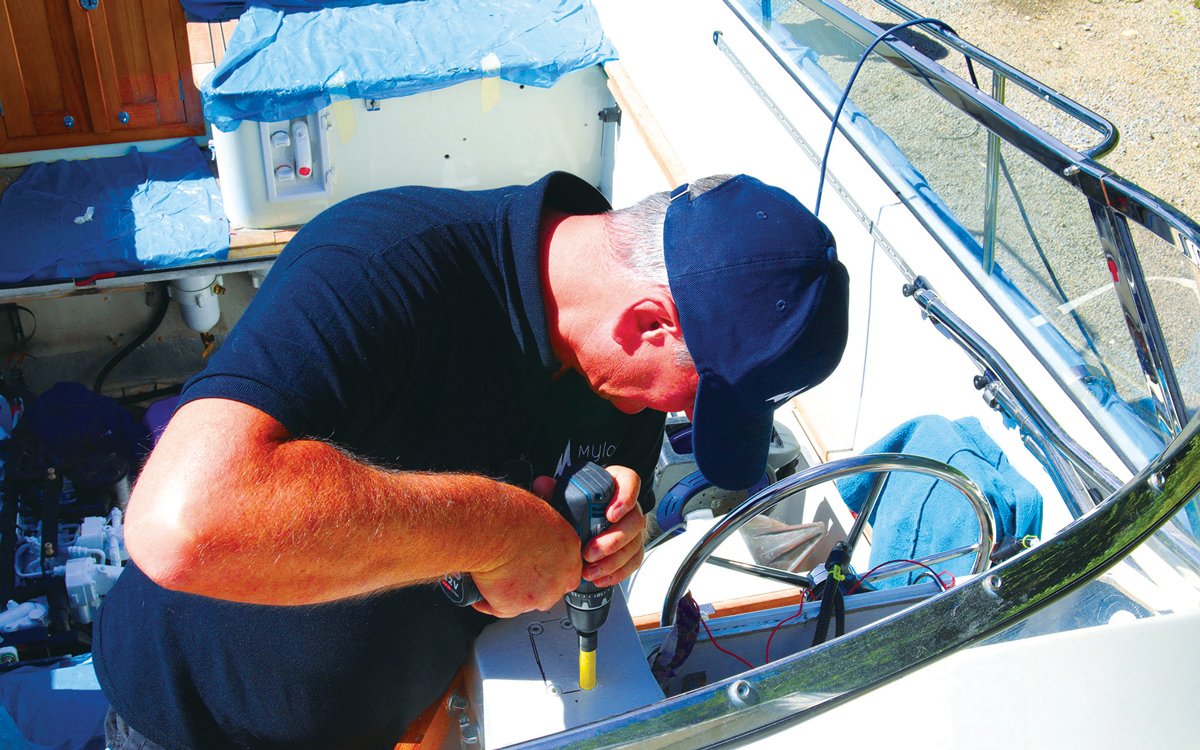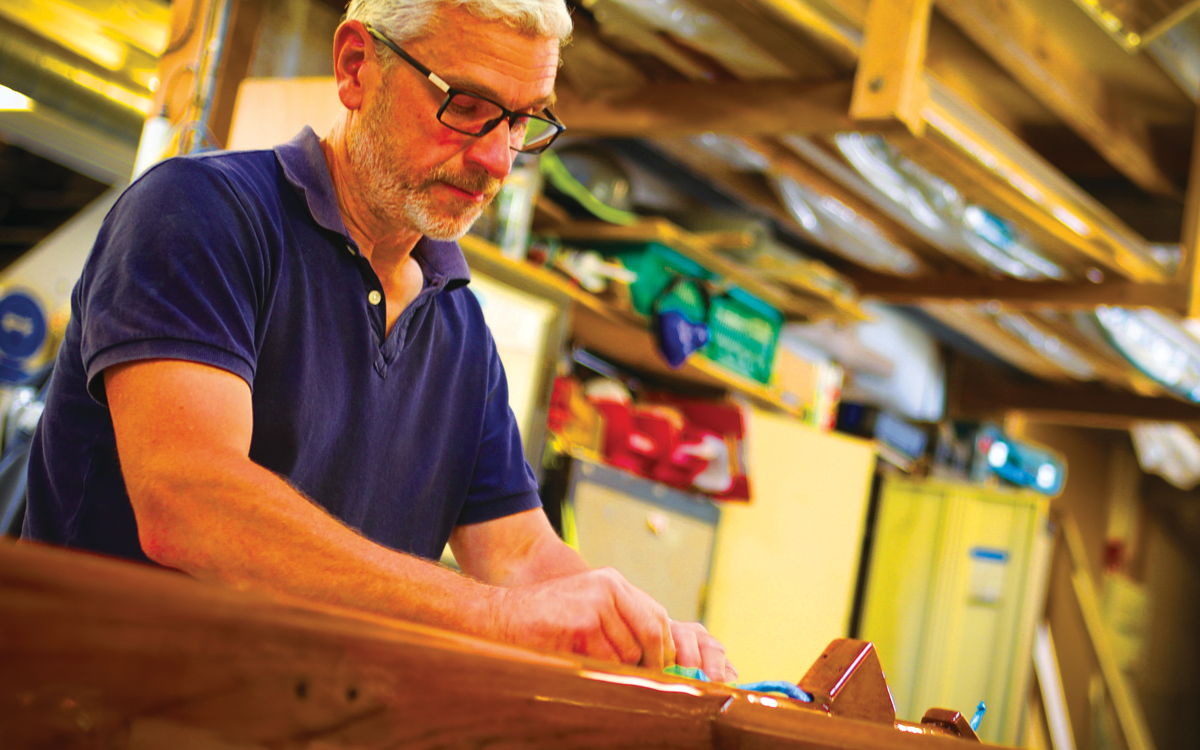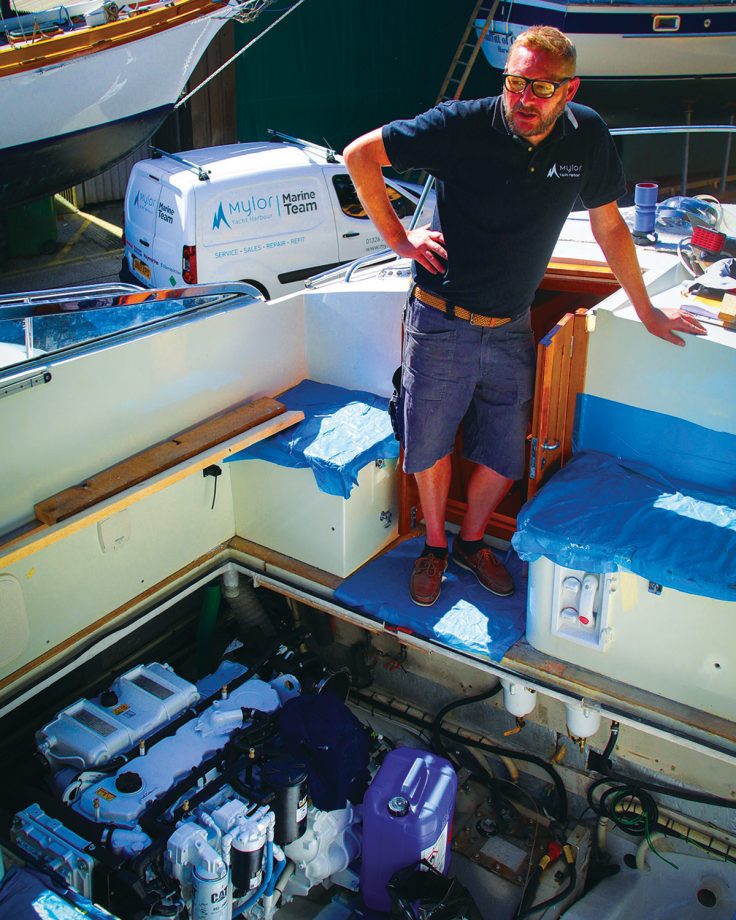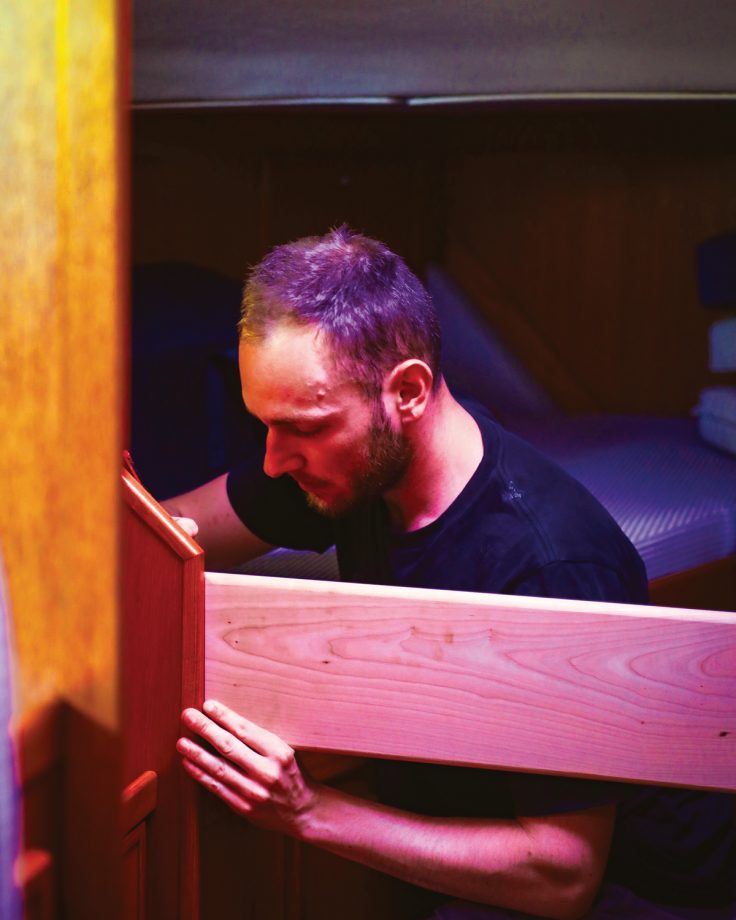Former professional sailor and windsurfer Stuart Sawyer took on his biggest challenge yet by restoring a Fairey Swordsman 40 back to mint condition.
I am an “in the blood” waterman, having grown up racing Mirror dinghies at National and European level before becoming a professional windsurfer in my 20s and moving to Hawaii where the waves were bigger. These days I am back in the UK sailing a J/122 called Black Dog III. My crew and I are the current RORC IRC National Champions.
None of this would have been possible without a supportive family so it seemed only right that I started looking for a boat that my wife and two grown-up daughters could enjoy as much as I did. We wanted something around 40ft long that could sleep four comfortably and six at a push for our Black Dog “cruises”, which entail a pub or three in Fowey or the Helford.
Off the water, I am CEO of a materials technology company called D3O, which specialises in impact protection, including helmet liners for American Football players and the defence sector, covers for mobile phones and protective clothing for motorcyclists.

Stuart took his J/122 Black Dog III to victory but a restored Fairey Swordsman is now his family boat
I had a budget up to £150,000-£160,00 to spend on a boat and as always I wanted to spend it wisely. I discounted a new boat because of the depreciation and decided I would be happier with an older classic anyway. The row-away factor (when you look back on the boat as you row ashore) was important to me, as was impeccable sea-keeping.
I considered a Dale Nelson 38 – great seakeeping and build quality – but my daughters felt it was ‘too slow and old for me’. They wanted something faster and prettier in which we could make quick passages to the Scillies, France and the Channel Islands.
In July 2019, after the RORC IRC prizegiving, I went for a walk to reflect on what we’d achieved and stumbled across a stunning Fairey Swordsman 40. Something connected with me – the iconic lines, corresponding curves, flared bow and open cockpit; everything about it oozed performance. Combined with my schoolboy dreams of being James Bond (even if it was a Fairey Huntress rather than a Swordsman that was used in the From Russia with Love chase scene) it seemed almost destined to be.
Article continues below…

From wreck to racer: The inside story of Thunderstreak’s remarkable restoration

From rotting wreck to classic cruiser: Restoring a Bates Star Craft 40
I recognise many of my decision points were emotive ones but the Swordsman did have the required four berths and a private owner’s cabin aft with its own heads: our sleeping times are not always compatible with those of our student daughters!
When a Swordsman came up for sale in Falmouth I took my wife to see it. The moment she stepped aboard I could see she liked it: the sociable but safe cockpit, the separate cabins and heads but it was when she stood back and admired the flared bow that she really started to smile – it emanated romantic nostalgia.
At the time of our viewing, the mouldy green decks, oil-filled bilges and rotting mast were thrust to the back of my mind – that was all for the survey. The initial negotiations did not go well. The boat was advertised at £149,000 but clearly had issues. The most obvious was a lack of use; it had spent the last two years ashore without the engines being serviced.
I discussed this with my brother Andrew, a yacht delivery skipper for PYD, and Nigel Musto, who also owns a Swordsman, and we all agreed that as well as a good survey, a sea trial with a Caterpillar engineer on board would be critical in order to assess the engines.

The dashboard had to be remade twice to fit the new analogue dials Stuart insisted on
The survey, carried out by Paul Kerridge at Mylor Yacht Harbour, read much as anticipated. The hull and structure were in good condition and extremely well built. Apparently it was one of the last made and had been commissioned by the yard’s owner but for some reason much of the interior had never been fully finished. The electrics had also suffered water ingress. All in all it was a sound boat that was suffering from lack of use and maintenance, but nothing that was insurmountable.
An initial inspection ashore by Finnings, the Caterpillar agents, found a number of issues with the engines – expensive but nothing that appeared terminal. I got some indicative pricing for refurbishing the boat and servicing the engines, and agreed on a sale price of £110,000 subject to sea trials.
When the allotted day came, we set out in a blustery force 6, steadily taking the engines up in 500rpm steps. I was amazed at the lack of slamming and how effortlessly she cut through the 4-6ft swell. Big smile.

Senior electrician Mark Howard gets stuck in fitting the new nav gear
Unfortunately, the same could not be said for the engines, which were heating up at an alarming rate. All kinds of alerts and warnings popped up on the Caterpillar agent’s laptop, to the point where we had to shut down the port engine, only to see the starboard engine also start peaking. After 30 minutes, on the advice of the engineer, we aborted the sea trial and limped back to Falmouth, alternating the engines to prevent overheating. The deal was off and the broker went back to the owner to seek direction.
Much to-ing and fro-ing ensued; sale on, sale off, further sea trials and more quotes as we investigated whether the engines could be fixed or would have to be replaced. I was looking at £36,000 + VAT to refurbish the old motors or £70,000 for two new ones. Eventually, six weeks after our initial offer and a painful negotiation process for both me and the previous owner, title transferred to me for £85,000. And a steep and expensive learning curve began!
The project
Tom Redgrave and Sandy Proctor, whom I sail with and work for Falmouth Harbour Commission, had just had the pilot boat re-engined by Mylor Yacht Harbour’s Marine Team, so recommended them for the engines.

Lowering the new Caterpillar engines onto the rebuilt bed supports
I called Roger Graffy, Chairman of Mylor Yacht Harbour, to explain my plans, and in a way only Roger can get away with, he confirmed that a) I was completely mad as I already had two boats, b) He completely understood as he loves being afloat more than ashore, c) His wife Dinah has a longstanding love affair with the Swordsman and d) Given the heritage of Fairey marine, it was exactly the kind of project Mylor would want to be involved in.
Off to Mylor she went and during deeper inspection of the old engines we did have one nice surprise – the gearboxes were in fine fettle, having done less than 400 hours in their 14 years. This meant we could keep the existing gearboxes and ‘bob-tail’ the new engines.
That brought the price down to £53,000 + VAT for new engines and refurbished gearboxes compared to £36,000 + VAT for overhauling the old engines. When I then received an offer of £12,000 to buy the old engines, I bit the bullet and decided to go for new engines.

Brand new engines were a major investment but worth the extra peace of mind
Nigel Musto was a mine of information on which engines to go for, having all the performance data of every Swordsman ever built. They would have to give the optimal balance of weight, fuel and performance but above all they had to have that distinctive Swordsman ‘sound’. We agreed that twin 455hp Caterpillar C7.1s were the way to go.
Engines
Opting for new engines required a structural change to the beds, as the 7.1s were 40mm taller. Once the old engines were removed and the fuel tanks shifted to allow access, Mylor Marine’s team cut back the beds and reinforced the bearers with steel and epoxy to take the new engine mounts.
After lifting the engines in, they then had to be aligned with the shafts. Chris Powell, the lead engineer, lived in the engine bay for the best part of six weeks and by the time he’d finished the alignment was so perfect (within 2,000s-of- an-inch) that he needed to add jubilee clips to stop them sliding out.

Engine beds were cut back…

…then reinforced with steel and epoxy to take the new Caterpillar 7.1s
Electrics
The main dashboard and cockpit control panel had rusted and missing buttons had allowed water to seep behind it, so that many of the switches and gauges were no longer working.
Mylor managed to source the original supplier and arranged for new panels to be cut and powder coated so as to maintain the original look and feel but also accommodate the new engines’ LCD control panels and a modern chartplotter. We opted for a Raymarine Axiom 9 as I wanted one with hard controls I could use when bouncing around at 25 knots.
We integrated this to the existing autopilot and after much debate decided to remove the old radar and install an AIS 700 system instead, albeit with wiring for a new radar to be added at a later date.

All-new electrics keep the helm and domestic systems running reliably
I also made two more non-budgeted decisions. The first was to install new fuel sensors into both tanks which fed into the Axiom for precise monitoring. The second was that on receipt of the new engine’s digital control panels, I felt they looked out of keeping with the Swordman’s classic style.
Mark Howard, Mylor’s senior electrician, managed to source some white and chrome analogue dials that could talk to the Cat engines but would look more in keeping. I know this was purely an aesthetic decision but having now used the boat, I am so glad we redid this.
The final step was adding a stereo system and speakers to the cockpit and saloon. With young daughters and their friends on board, I felt this would be a fun, albeit rather extravagant, extra. We opted for a Fusion RA70N as this could be controlled from the Axiom as well as via Bluetooth without having to go down below.

Interior
Parts of the original fit out had never been fully finished – maybe because it was used mainly as a day boat. This was evident from the paucity of storage and lack of wear and tear inside. I contacted Rob Holdroff, a local carpenter, who had just set up on his own having previously worked at Pendennis. We met at the boat and drew up a schedule of works.
A key request from my daughters was to make the vee berth convertible to a double with the aid of a wooden infill and mattress. Given the British weather, I also wanted to create a wet locker in the front cabin, which drains into the bilges, where damp clothing could dry with the aid of central heating.
The galley was problematic, as the cupboards opened directly onto the GRP structure and lacked any shelves. My wife Ruth worked out what we would need for family cruises, purchased the plates, bowls, cups, mugs and glasses, then we designed and fitted out the cupboards specifically to fit them.

Every locker had to be re-lined with new shelves made to measure
We did the same for all the lockers in the saloon, making spaces and draws for pilot books, safety equipment, odds and sods, and of course bottle holders! In the aft cabin, Rob made liners and shelves that would protect our clothes from condensation, in all cases matching the cherry wood finish to the original.
Exterior
Much of the exterior needed sorting. The teak decks were covered in algae, split in places and the caulking was shot. The wooden rubbing strake on the bow had split and was missing several pieces. The anchor locker hatch had warped and wouldn’t close. The gas bottle had left rust streaks down the topsides and inside the locker. The blue transom had faded to such an extent that I wondered if it would ever come back to its true colour.
As the Mylor team were focussed on the engines and electrics, I asked Tim Seaman at Formation Marine to take on this. Tim had repaired Black Dog after we hit the committee boat at a start in Dartmouth, so I knew how skilled he was with both wood and GRP. Tim did a great job of cutting back and restoring the transom giving us an early win that helped to show how she would end up looking.

Hours of back-breaking work went into restoring the original teak foredeck
Together, we worked out which lockers could hold what; life raft, inflatable tender and 2.5hp outboard, as I didn’t want davits to ruin the boat’s lines. Tim then set about repairing, replacing and where necessary recreating the locker lids and liners as well as refurbishing the decks and rubbing strake.
The cockpit shower mounted inside one of the deck lockers was also a write off. Tim replaced the cracked pipework with flexible hosing to protect it when throwing in warps and fenders. Last but not least, the mast, which I have always seen as a key part of the Fairey’s iconic design, was so badly discoloured that it was bordering on the point of no return.
Tim rose to the challenge, removed the mast, took it home and over the winter spent hours drying, sanding and cutting it back, followed by countless coats of varnish to restore it to its former glory. It has probably had more TLC than any other single part of the boat.

The iconic mast was a sorry sight of peeling varnish and rotting wood
Frustratingly the new engines arrived on the very day lockdown was imposed, causing a delay of almost three months. Once the project was underway again, it slipped a further three weeks, largely down to needing to replace the risers, which had corroded and split, damaging the old engines.
This, the new instrument panel, the stereo and the mast and decks needing more work than anticipated pushed us over my original budget and the 10 percent contingency I’d built onto it by a further 10 per cent. Finally, once we had the boat stripped and the engines taken out, we decided to replace rather than service all but two of the through-hull fittings for peace of mind and ease of maintenance.
The result
Despite this I thoroughly enjoyed the refit process. Going over every inch, inside and out, and agreeing the practical detail has made me feel more connected with the boat. Working with great tradespeople was a key part of this. Nathan Percival, the project manager at Mylor Yacht Harbour, made the process easier for me, even if it aged him!

Afloat again and revelling in the power of her new 455hp Caterpillar engines
Tim Seaman has to be credited for how good Freebird now looks. Rob Holdroff has made it so much more practical and pleasant to live aboard. Mark Howard and Chris Powell worked tirelessly on the new engines and electronics.
I think I was fortunate that this wasn’t a normal job, having a classic boat which people genuinely wanted to work on made a noticeable difference. Each of the teams were interested to see how the others were getting on and everyone seemed to develop their own connection with the boat, which is evident in the craftsmanship and high quality work on show.
Whether it has paid off financially is hard to say; Sworsdman 40s vary between £150,000 and £225,000 depending on their condition and specification. I would say that Freebird is one of, if not the best, example out there and would be likely to sit at the higher end of the price bracket.

Classic lines with a deep-vee hull and heavily flared bow to help part the waves
That said I don’t think owning any boat should be about making money. I knew I had to be sensible with the costs and even though I got swept along with some of the more aesthetic decisions, I wasn’t in a position to just throw money at it and let someone else manage the project. I was heavily involved in all of the decisions throughout the process and, ironically, not being able to travel for business meant I could be onsite two or three times a week.
Now the plan is to use Freebird with the family, starting off with small cruises to bed the boat in. We have already enjoyed short trips and overnights to the Helford River allowing us to go through some inevitable snagging, which I am delighted to say was minor!
Fowey and the Isles of Scilly are next on the list of destinations to head for, which are all within short 1-4 hour passages, while L’Aber W’rach and Roscoff are on my daughters’ list to visit as soon as Covid restrictions lift. If this all goes well we are brewing a plan for 2021 to take the boat around Britain and Ireland. This has been on my bucket list for some time and while I had originally planned to do it by sail, Freebird is now emerging as the perfect craft for the job.

My plan for this circumnavigation is to head west from Falmouth to the Scillies, then over to Kinsale and around the West coast of Ireland. I’d then make my way up the west coast of Scotland around Cape Wrath, down the east coast and into London, before the final leg along the south coast and home to Cornwall. Having put this much time and effort into perfecting Freebird, it seems only right to make the most of what she has to offer. I promise to keep you posted…
The cost
Interior lockers and berth conversion – £2,000
Teak decking, topsides, transom, mast, external lockers, glass repairs and antifoul – £7,800
New engines – £65,200 (£57,840 + £19,400 fitting, less £12,000 for old engines)
Electronics – chartplotter, AIS, fuel sensors, dials, panels, stereo, LED nav lights, rewiring – £9,800
Replacing through-hull fittings, servicing all stop cocks, pipe works, outside shower – £2,400
Canopy and cockpit cover, repairing old tonneau – £4,800
New risers, exhaust manifold, welding, moving electric panel and generator – £4,900
Extinguisher upgrade, tender, outboard, liferaft etc. – £6,000
Total refit cost – £102,900
Boat purchase – £85,000
First published in the December 2020 issue of Yachting World.

The gas locker was covered in rust stains and green algae

The side decks were in a similar state after two years ashore

The propellers were polished to perfection

Project manager Nathan Percival oversees the complex installation process

The forecabin now makes up to a double bed when needed

New vee-berth infill was made to match the existing woodwork


Full-length canopy cover makes the open cockpit useable all year round










